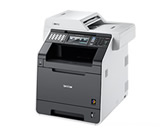MFC-9970CDW
FAQs & Troubleshooting |
What is the recommended paper?
You can use the following types of print media: thin paper, plain paper, thick paper, bond paper, recycled paper, glossy paper, labels or envelopes.
Print quality may vary according to the type of paper you are using. For best results, follow the instructions below:
- DO NOT put different types of paper in the paper tray at the same time because it may cause paper jams or misfeeds.
- Choose the same paper size from your software application as the paper in the tray.
- Avoid touching the printed surface of the paper immediately after printing.
- Before you buy a lot of paper, test a small quantity to make sure that the paper is suitable.
- Store paper in its original packaging and keep it sealed.
- Keep the paper flat and away from moisture, direct sunlight and heat.
Recommended paper specifications
The following paper specifications are suitable for this machine.
| Basis weight | 75-90 g/m2 (20-24 lb) |
| Thickness | 80-110 μm |
| Roughness | Higher than 20 sec. |
| Stiffness | 90-150 cm3/100 |
| Grain direction | Long grain |
| Volume resistivity | 10e9-10e11 ohm |
| Surface resistivity | 10e9-10e12 ohm-cm |
| Filler | CaCO3 (Neutral) |
| Ash content | Below 23 wt% |
| Brightness | Higher than 80% |
| Opacity | Higher than 85% |
- Use paper that is made for plain-paper copying.
- Use paper that is 75 to 90 g/m2 (20 to 24 lb)
- Use long grain paper with a neutral Ph value, and a moisture content of approx. 5%.
- This machine can use recycled paper that meets DIN 19309 specifications.
Notes for using special paper
- DO NOT use inkjet paper because it may cause a paper jam or damage your machine.
- Preprinted paper must use ink that can withstand the temperature of the machine's fusing process 200 degrees centigrade (392 degrees Fahrenheit).
- If you use bond paper, paper having a rough surface or paper that is wrinkled or creased, the paper may
exhibit degraded performance. - When you are using glossy paper, put only one sheet at a time in the MP tray to avoid a paper jam.
Notes for using envelopes
- Use envelopes that have edges with straight, well-creased folds and the leading edge should not be thicker than two sheets of paper.
- Use envelopes that lie flat and is not of baggy or flimsy construction.
- Buy quality envelopes from a supplier who understands that you will be using the envelopes in a laser machine.
Notes for using labels
- Use labels that have an adhesive that is acrylic-based since this material is more stable at the high temperatures in the fuser unit.
- Adhesives should not come in contact with any part of the machine, because the label stock may stick to the
drum unit or rollers and cause jams and print quality problems. No adhesive should be exposed between the labels. Labels should be arranged so that they cover the entire length and width of the sheet. - DO NOT reuse or insert labels that have previously been used or are missing few labels on the sheet. Using labels with spaces may result in labels peeling off and causing serious jams or print problems.
- All labels used in this machine must be able to withstand a temperature of 200 degrees centigrade (392 degrees Fahrenheit) for a period of 0.1 seconds.
Content Feedback
To help us improve our support, please provide your feedback below.
